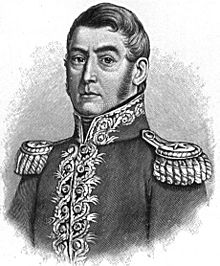José de San Martín
José de San Martín (born February 25, 1778 in Yapeyú , viceroyalty of the Río de la Plata , today Argentina , † August 17, 1850 in Boulogne-sur-Mer , France ) was a South American independence fighter .
Life
San Martín was born to Spanish parents in Yapeyú in the viceroyalty of La Plata in what is now Argentina . He grew up in Spain and went through an officer career in the Spanish army, which he served for 20 years. During this time, San Martín increasingly sided with the independence of the Spanish colonies in South America.
In 1812 he returned to Cuyo and trained a revolutionary army for the struggle for independence. In contrast to other South American revolutionaries, San Martín did not initially focus on Peru , but on the liberation of Chile . First, however, he took over the office of governor in Mendoza , western Argentina , where he set up an army largely without the support of the state government. The Chilean general Bernardo O'Higgins was his most important confidante. In 1816 he organized the Andean Army , a military unit consisting of 3,500 to 6,000 soldiers and 1,200 auxiliary troops. In 1817 this regiment marched across the Andes in a spectacular way for that time , defeated the Spaniards at Chacabuco in Chile and occupied the capital Santiago de Chile . In 1818, after a decisive victory over the Spaniards in Maipú , San Martín set up a national government in Chile, but he turned down the office of president in favor of Bernardo O'Higgins.
In 1820 he led an operation to liberate Peru from Spanish rule (see: Expedition of San Martín ), for which he was able to strengthen his army with new Chilean troops. He defeated the Spaniards at Pisco in December 1820 , first secured the support of a strong aristocratic party and only then occupied Lima , where he proclaimed Peru's independence on July 28, 1821 and was made the country's protector .
The continued resistance of the Spaniards in Peru and disputes within his army led him to seek military support from the Venezuelan general and revolutionary Simón Bolívar . The two revolutionaries, however, disagreed on questions of government policy. While San Martín sought a monarchy, Bolívar held on to the establishment of a republic. On July 26th and 27th, 1822, the two leaders of the Wars of Independence tried ultimately unsuccessfully to resolve the differences at meetings in Guayaquil . To this day it is unclear whether San Martín resigned of his own free will, in the hope that Bolívar would better serve the road to independence, or whether Bolívar made this step a condition for his aid in Peru.
In 1824, San Martín went to Europe, where he died on August 17, 1850 in Boulogne-sur-Mer in northern France . He had spent the last two years of his life in house number 113 on the Grande Rue there , which now houses a museum dedicated to him.
Between 1850 and 1861 he was buried in the crypt of the Basilica of Notre-Dame de Boulogne. Because his will in his will for a funeral in Buenos Aires could only be granted later due to political turmoil, his now embalmed body was buried in the cemetery of Boulogne-sur-Mer. On May 29, 1880, during the presidency of Nicolás Avellaneda , his remains were finally transferred to Argentina and buried in a mausoleum in the cathedral of Buenos Aires .
Honors
After San Martín, the city of San Martín in the province of Buenos Aires , the place Libertador General San Martín in the province of Jujuy and the border town of José de San Martín (Chubut) as well as other locations, z. B. the Plaza General San Martín in the capital.
The main inner belt asteroid (2745) San Martin is named after José de San Martín.
gallery
Statue in Berlin-Tiergarten near the Potsdamer Bridge
Bust in the Donaupark , Vienna
Bust in Tarija , Bolivia (near the San Martín Bridge at the entrance to the Barrio San Martín)
literature
- Horst Pietschmann : José de San Martin. In: Nikolaus Werz (ed.): Populists, revolutionaries, statesmen. Politicians in Latin America. ( Bibliotheca Ibero-Americana ; Vol. 129.) Vervuert, Frankfurt am Main 2010, ISBN 978-3-86527-513-4 , pp. 50-78.
- Ernst Samhaber : South America. Goverts, Hamburg 1939, p. 449.
Foreign language literature:
- John Lynch: Caudillos in Spanish America, 1800-1850. Clarendon Press, Oxford 1992, ISBN 978-0198211358 .
- John Callan James Metford: San Martin, the Liberator. Blackwell, New York 1950.
- Bartolomé Miter : Historia de San Martin y de la Emancipación Sudamericana. Félix Lajouane Verlag, Buenos Aires 1890. Digitized edition in the Internet Archive .
- Academia Nacional de la historia (Argentina): Nueva historia de la nación Argentina , 2nd edition, Volume 4. Editorial Planeta, Buenos Aires 2000, ISBN 950-49-0389-4 , p. 318.
Web links
- Museum in the house of San Martín in Boulogne (France)
- Newspaper article about José de San Martín in the 20th century press kit of the ZBW - Leibniz Information Center for Economics .
Individual evidence
- ^ Lutz D. Schmadel : Dictionary of Minor Planet Names . Fifth Revised and Enlarged Edition. Ed .: Lutz D. Schmadel. 5th edition. Springer Verlag , Berlin , Heidelberg 2003, ISBN 978-3-540-29925-7 , pp. 186 (English, 992 pp., Link.springer.com [ONLINE; accessed on September 11, 2019] Original title: Dictionary of Minor Planet Names . First edition: Springer Verlag, Berlin, Heidelberg 1992): “1976 SR 10 . Discovered 1976 Sept. 25 at the Carlos U. Cesco Observatory at El Leoncito. "
| personal data | |
|---|---|
| SURNAME | San Martín, José de |
| BRIEF DESCRIPTION | South American independence fighter |
| BIRTH DATE | February 25, 1778 |
| PLACE OF BIRTH | Yapeyú , Argentina |
| DATE OF DEATH | 17th August 1850 |
| PLACE OF DEATH | Boulogne-sur-Mer , France |









